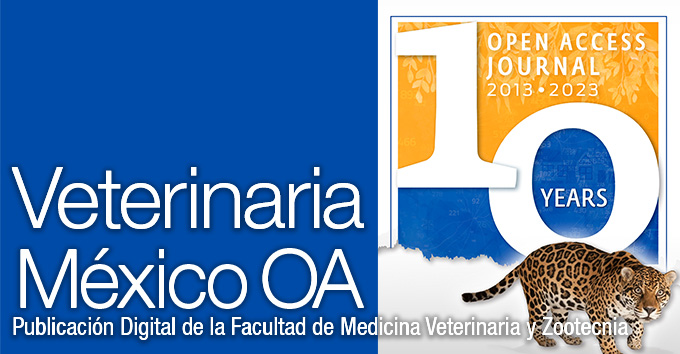Molecular markers associated with response to vaccination against Porcine Reproductive and Respiratory Syndrome virus in a commercial swine farm from southern Sonora
Main Article Content
Abstract
Porcine Reproductive and Respiratory Syndrome (PRRS) is a viral disease that seriously affects the swine industry. The main method of control is vaccination, which has shown variable effectiveness partly attributed to genetic variability in sows. The objective was to validate single-nucleotide polymorphisms (SNPs) associated with performance traits following PRRS vaccination in replacement sows. A population of 100 Landrace(¾) / Yorkshire(¼) commercial line sows of 6 months of age, an average weight of 108 kg, and negative for PRRS virus were used. After an acclimatization stage, sows were vaccinated against PRRS (day 0). Daily weight gain (DWG) and rectal temperature (RT) were recorded on days 0, 7, 14, 21, and 28. A blood sample was individually collected on day 40 and used for DNA extraction and genotyping of 59 SNPs. These SNPs were previously identified through genomic analysis as associated with a vaccination response indicator. The 59 SNPs were validated in this study using a statistical mixed-effects model that included DWG or RT as response variables. From 59 SNPs, 5 of them were associated with DWG (P < 0.05), and 3 with RT (P < 0.05). Interestingly, the SNPs in the genes DENND5A (rs81409931 and rs81216494) and COL22A1 (rs329119519 and rs81381462) were associated with both DWG and RT, and they showed a higher allele contribution effect on phenotypes. These 2 genes appeared to be functionally related to DWG; therefore, their corresponding 4 SNPs are proposed as genetic markers associated with the response to PRRS vaccination in replacement sows from southern Sonora.
Article Details
References
Del Moral-Barrera LE, Ramírez-Gómez BP, Muñoz-Jumilla AR. Crecimiento regional de la producción de carne de cerdo en México, 1980-2005. Análisis Económico. 2008;xxiii(52):271-290. https://www.redalyc.org/articulo.oa?id=41311484015
López-Heydeck SM, Alonso-Morales RA, Mendieta-Zerón H, Vázquez-Chagoyán JC. Porcine reproductive and respiratory syndrome (PRRS): review. Revista Mexicana de Ciencias Pecuarias. 2015;6(1):69-89.
Arias M, Agüero M, Sánchez C, Romero LJ, Canals A, Gómez-Tejedor C, Sánchez Vizcaíno JM. Detection of PRRS virus in pig sera and semen with a newly developed PCR method: in vivo, in vitro and field testing. Mac.Journal of Animal Reproduction. 2000;6(1);69-81.
Prather RS, Wells KD, Whitworth KM, Kerrigan MA, Samuel MS, Mileham A, Popescu LN, Rowland RRR. Knockout of maternal CD163 protects fetuses from infection with porcine reproductive and respiratory syndrome vi rus (PRRSV). Scientific Reports. 2017;7. Article No: 13371. doi: 10.1038/ s41598-017-13794-2.
Holtkamp DJ, Kliebenstein JB, Neumann EJ, Zimmerman JJ, Rotto HF, Yoder TK, Wang C, Yeske PE, Mowrer CL, Haley CA. Assessment of the economic impact of porcine reproductive and respiratory syndrome virus on United States pork producers. Journal of Swine Health Production. 2013;21(2):72-84.
Nan Y, Wu C, Gu G, Sun W, Zhang YJ, Zhou EM. Improved vaccine against PRRSv: current progress and future perspective. Frontiers in Microbiology. 2017;8:1635. doi:10.3389/fmicb.2017.01635.
Rowland RRR, Lunney J, Dekkers J. Control of porcine reproductive and respiratory syndrome (PRRS) through genetic improvements in disease resistance and tolerance. Frontiers in Genetics. 2012;3:260. doi:10.3389/fgene.2012.00260.
Butler JE, Lager KM, Golde W, Faaberg KS, Sinkora M, Loving C, Zhang YI. Porcine reproductive and respiratory syndrome (PRRS): an immune dysregulatory pandemic. Immunologic Research. 2014;59:81-108. doi:10.1007/ s12026-014-8549-5.
Sanglard LP, Fernando RL, Gray KA, Linhares DCL, Dekkers JCM, Niederwerder MC, Serão NVL. Genetic analysis of antibody response to Porcine Reproductive and Respiratory Syndrome vaccination as an indicator trait for reproductive performance in commercial sows. Frontiers in Genetics. 2020;11:1011. doi:10.3389/fgene.2020.01011.
Sanglard LP, Huang Y, Gray KA, Linhares D, Dekkers J, Niederwerder MC, Fernando RL, Serão N. Further host-genomic characterization of total antibody response to PRRSV vaccination and its relationship with reproductive performance in commercial sows: genome-wide haplotype and zygosity analyses. Genetics Selection Evolution. 2021;53. Article No: 91. doi:10.1186/ s12711-021-00676-5.
Aguilar-Trejo CM, Luna-Nevárez G, Reyna-Granados JR, Zamorano-Algandar R, Romo-Rubio JA, Sánchez-Castro MA, Enns RM, Speidel SE, Thomas MG, Luna Nevárez P. Polymorphisms associated with the number of live-born piglets in sows infected with the PRRS virus in southern Sonora Mexico. Revista Mexicana de Ciencias Pecuarias. 2020;11(3):828-847. doi:10.22319/rmcp.v11i3.5002.
Mohammadi A, Nassiry MR, Mosafer J, Mohammadabadi MR, Sulimova GE. Distribution of BoLA-DRB3 allelic frequencies and identification of a new allele in the Iranian cattle breed Sistani (Bos indicus). Russian Journal of Genetics. 2009;45(2):198-202. doi:10.1134/S1022795409020100.
Mohammadabadi MR. Tissue-specific mRNA expression profile of ESR2 gene in goat. Agricultural Biotechnology Journal. 2021;12(4):167-181. doi:10.22103/ jab.2021.17011.1284.
Javanmard A, Mohammadabadi MR, Zarrigabayi GE, Gharahedaghi AA. Polymorphism within the intron region of the bovine leptin gene in Iranian Sarabi cattle (Iranian Bos taurus). Russian Journal of Genetics. 2008;44(4):495-497. doi:10.1134/S1022795408040169.
Roudbar MA, Abdollahi-Arpanahi R, Mehrgardi AA, Mohammadabadi M et al. Estimation of the variance due to parent-of-origin effects for productive and reproductive traits in Lori-Bakhtiari sheep. Small Ruminant Research. 2018;160:95- 102. doi:10.1016/j.smallrumres.2018.01.022.
Mousavizadeh A, Abadi MM, Torabi A, Nassiry MR, Ghiasi H, Koshkoieh AE Genetic polymorphism at the growth hormone locus in Iranian Talli goats by polymerase chain reaction-single strand conformation polymorphism (PCRSSCP). Iranian Journal of Biotechnology. 2009;7(1):51-53.
Masoudzadeh SH, Mohammadabadi MR, Khezri A et al. Dlk1 gene expression in different tissues of lamb. Iranian Journal of Applied Animal Science. 2020;10(4):669-677.
Mohammadabadi MR, Soflaei M, Mostafavi H, Honarmand M. Using PCR for early diagnosis of bovine leukemia virus infection in some native cattle. Genetics Molecular Research. 2011;10(4):2658-2663. doi:10.4238/2011. October.27.2.
Ahsani MR, Mohammadabadi MR, Shamsaddini MB. Clostridium perfringens isolate typing by multiplex PCR. Journal of Venomous Animals and Toxins including Tropical Diseases. 2010;16(4):573-578. doi:10.1590/ S1678-91992010000400006.
Nassiry MR, Shahroodi FE, Mosafer J, Mohammadi A, Manshad E, Ghazanfari S, Mohammad Abadi MR, Sulimova GE. Analysis and frequency of bovine lymphocyte antigen (BoLA-DRB3) alleles in Iranian Holstein cattle. Russian Journal of Genetics. 2005;41(6):664-668. doi:10.1007/s11177-005-0142-5.
Norouzy A, Nassiry MR, Eftekhari Shahrody F, Javadmanesh A, Mohammad Abadi MR, Sulimova GE. Identification of bovine leucocyte adhesion deficiency (BLAD) carriers in Holstein and Brown Swiss AI bulls in Iran. Russian Journal of Genetics. 2005;41(12):1409-1413. doi.10.1007/s11177-006-0014-7.
Sulimova GE, Azari MA, Rostamzadeh J, Mohammad Abadi MR, Lazebny OE. κ-casein gene (CSN3) allelic polymorphism in Russian cattle breeds and its information value as a genetic marker. Russian Journal of Genetics. 2007;43(1):73- 79. doi:10.1134/S1022795407010115.
Luna-Nevárez G, Aguilar-Trejo CM, Luna-Ramirez RI, Zamorano-Algandar R, Zeng X, Enns RM, Speidel SE, Thomas MG, Luna-Nevárez P. Identificación de regiones genómicas asociadas a respuesta a la vacunación contra el PRRS en cerda reproductoras del sur de Sonora, México. Revista Latinoamericana de Recursos Naturales. 2017:13(1);15-23.
Habier D, Fernando RL, Kizilkaya K, Garrick DJ. Extension of the bayesian alphabet for genomic selection. BMC Bioinformatics. 2011:12;186. doi:10.1186/1471-2105-12-186.
Littell R, Stroup W, Freund R. SAS for linear models. 4th ed. North Carolina, US; SAS Institute Inc., Cary; 2002.
Saxton AM, Balzarini MG, Cappio-Borlino A, Czika W, Fry JD, Gibson G. Genetic analysis of complex traits using SAS. North Carolina, US: SAS Institute, Inc.; 2004.
Falconer DS, Mackay, TFC. Introduction to quantitative genetics. 4th ed. New York, NY: Longman Scientific and Technical; 1996.
Sherman E, Nkrumah JD, Murdoch BM, Li C, Wang Z, Fu A, Moore SS. Polymorphisms and haplotypes in the bovine neuropeptide Y, growth hormone receptor, ghrelin, insulin-like growth factor 2, and uncoupling proteins 2 and 3 genes and their associations with measures of growth, performance, feed efficiency, and carcass merit in beef cattle. Journal of Animal Science. 2008;86(1):1-16. doi:10.2527/jas.2006-799.
Senasica. Panorama Internacional del Síndrome Reproductivo y Respiratorio Porcino: Análisis Estratégico de Riesgos Sanitarios (PDF). CDMX, México; 2020. https://dj.senasica.gob.mx/Contenido/files/2022/ agosto/00011PAIPRRS04012022_e1c3bf38-f35f-4d5e-8b6d-3bd8c6c64063_e1c3bf38-f35f-4d5e-8b6d-3bd8c6c64063.pdf
Quezada-Fraide EA, Peñuelas-Rivas CG, Moysén-Albarrán FS, Trujillo-Ortega ME, Martínez-Castañeda FE. Desempeño productivo y costos de granjas porcinas con diferentes protocolos de vacunación al virus del PRRS. Revista Mexicana de Ciencias Pecuarias. 2021;12(1):205-216. doi:10.22319/rmcp.v12i1.5377.
Boddicker N, Waide EH, Rowland RRR, Lunney JK, Garrick DJ, Reecy JM, Dekkers JCM. Evidence for a major QTL associated with host response to Porcine Reproductive and Respiratory virus syndrome challenge. Journal of Animal Science. 2012;90:1733-1746. doi:10.2527/jas.2011-4464.
Castillo-Salas CA, Luna-Nevárez G, Reyna-Granados JR, Luna-Ramirez RI, Limesand SW, Luna-Nevárez P. Molecular markers for thermo-tolerance are associated with reproductive and physiological traits in Pelibuey ewes raised in a semiarid environment. Journal of Thermal Biology. 2023;112:103475. doi:10.1016/j.jtherbio.2023.103475.
Aguilar-Trejo CM, Romo-Rubio JA, Zamorano-Algandar R, Luna-Nevárez G, Thomas MG, Enns RM, Speidel SE, Sánchez-Castro MA, Reyna-Granados JR, Luna- Nevárez P. Polimorfismos de nucleótido simple asociados a servicios por concepción en cerdas infectadas con el virus del PRRS. Revista Latinoamericana de Recursos Naturales. 2017;13(2):32-18.
Pérez O. Sistema de producción porcina (PDF). SAGARPA. México. 2000. http:// www.ciap.org.ar/Sitio/Archivos/Sistema%20de%20produccion%20Porcina.pdf
Friedman JE. Metabolismo de la Glucosa en el Músculo Esquelético. PubliCE; 2002.
Herrera-Batista AJ, Ruíz-Candina HJ, Zumeta-Dubé MT. The super family of the collagen. Revista Cubana de Investigaciones Biomédicas. 2017;36(2):260-270.
Morón-Fuenmayor OE, González-Méndez NF, Vázquez-Ortiz F. Contenido de colágeno y sus fracciones en tres músculos de toretes comerciales. Revista Científica. 2004;14(3). https://www.redalyc.org/articulo.oa?id=95914312
García TA, Ozaki GAT, Castoldi RC, Job AE, Camargo RCT, Filho JCSC, Belangero WD. Collagen I and III ratios and tenacity of rats’ muscle injured and treated with platelet-rich plasma. International Journal of Morphology. 2020;38(5):1392- 1397. doi:10.4067/S0717-95022020000501392.
Lebret B, Guillard AS. Outdoor rearing of cull sows: Effects on carcass, tissue composition and meat quality. Meat Science. 2005;70(2):247-257. doi:10.1016/j. meatsci.2005.01.007.
Della-Rosa MM. Color y resistencia al corte de la carne de novillos suplementados con niveles crecientes de semilla de lino [Tesis doctoral]. Mar del Plata, Argentina: Universidad Nacional de Mar del Plata; 2016.
License

Veterinaria México OA by Facultad de Medicina Veterinaria y Zootecnia - Universidad Nacional Autónoma de México is licensed under a Creative Commons Attribution 4.0 International Licence.
Based on a work at http://www.revistas.unam.mx
- All articles in Veterinaria México OA re published under the Creative Commons Attribution 4.0 Unported (CC-BY 4.0). With this license, authors retain copyright but allow any user to share, copy, distribute, transmit, adapt and make commercial use of the work, without needing to provide additional permission as long as appropriate attribution is made to the original author or source.
- By using this license, all Veterinaria México OAarticles meet or exceed all funder and institutional requirements for being considered Open Access.
- Authors cannot use copyrighted material within their article unless that material has also been made available under a similarly liberal license.



